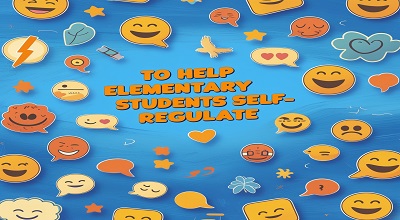Self-regulation strategies for elementary students
Self-regulation strategies for elementary students: Self-regulation is a critical skill for elementary students, helping them manage their emotions, behavior, and focus in the classroom. When students learn to self-regulate, they perform better academically, build stronger relationships, and develop lifelong emotional intelligence.
In this comprehensive guide, we’ll explore 15 effective strategies to help elementary students self-regulate, incorporating the latest research and practical classroom techniques. Whether you’re a teacher, educator, or parent, these methods will empower students to take control of their learning and emotional well-being.
Why Self-Regulation Matters for Elementary Students?
Self-regulation is the ability to:
- Control impulses
- Manage emotions
- Stay focused on tasks
- Adapt to changing situations
Children who struggle with self-regulation may exhibit:
- Difficulty following instructions
- Frequent emotional outbursts
- Trouble transitioning between activities
- Poor impulse control
By teaching self-regulation early, we set students up for long-term success in school and beyond.
15 Proven Ways to Help Elementary Students Self-Regulate
1. Teach Emotional Vocabulary
Students need words to express their feelings. Use emotion charts, books, and role-playing to help them identify and articulate emotions like frustration, excitement, or sadness.
2. Implement Mindfulness Activities
Mindfulness exercises, such as deep breathing and guided imagery, help students calm their minds and bodies. Try:
- 5-Finger Breathing
- Mindful Listening exercises
3. Use Visual Schedules
A structured routine reduces anxiety. Post a visual schedule with pictures to help students anticipate transitions and manage expectations.
4. Introduce “Calm Down” Corners
A designated quiet space with sensory tools (stress balls, coloring sheets) allows students to regain composure when overwhelmed.
5. Model Self-Regulation
Children learn by watching adults. Demonstrate how you handle frustration or stress in real-time.
6. Practice Positive Self-Talk
Encourage students to replace negative thoughts (“I can’t do this”) with empowering statements (“I’ll try my best”).
7. Incorporate Movement Breaks
Short bursts of physical activity (stretching, dancing) help reset attention and energy levels.
8. Teach Problem-Solving Steps
Guide students through conflict resolution:
- Identify the problem
- Brainstorm solutions
- Choose the best option
- Evaluate the outcome
9. Use Social Stories
Stories depicting common challenges (sharing, waiting turns) help students understand expected behaviors.
10. Reward Self-Regulated Behavior
Reinforce positive actions with praise, stickers, or a class reward system.
11. Encourage Goal Setting
Help students set small, achievable goals (e.g., “Raise my hand before speaking”) and track progress.
12. Play Cooperative Games
Team-based games teach patience, turn-taking, and emotional control.
13. Teach Sensory Regulation Techniques
Some students need sensory input (chewing gum, fidget tools) to stay focused.
14. Foster a Growth Mindset
Emphasize that mistakes are part of learning. Phrases like, “You’re still growing!” build resilience.
15. Partner with Parents
Share strategies with families so self-regulation is reinforced at home.
FAQs About Helping Students Self-Regulate
1. What is self-regulation in elementary students?
Self-regulation is the ability to manage emotions, behaviors, and attention in different situations.
2. Why do some students struggle with self-regulation?
Factors include developmental delays, ADHD, anxiety, or lack of explicit instruction in emotional control.
3. How long does it take for students to learn self-regulation?
It varies, but consistent practice over weeks or months leads to improvement.
4. Can technology help with self-regulation?
Yes! Apps like Calm or Headspace for Kids teach mindfulness and relaxation.
5. What if a student resists self-regulation strategies?
Start small, offer choices (“Do you want to take deep breaths or draw?”), and be patient.
Conclusion
Helping elementary students develop self-regulation skills is a transformative part of education. By integrating these 15 strategies, educators and parents can create a supportive environment where children thrive emotionally and academically.
